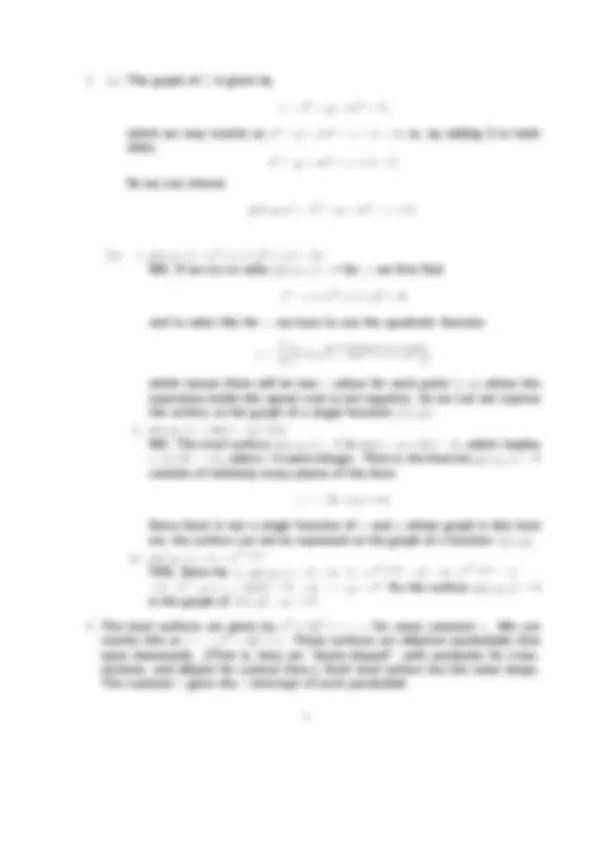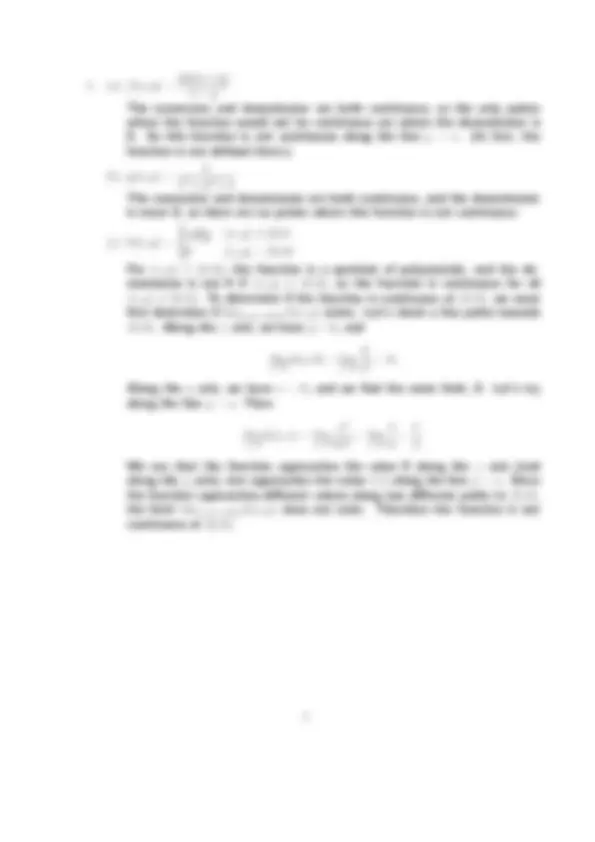





Study with the several resources on Docsity

Earn points by helping other students or get them with a premium plan


Prepare for your exams
Study with the several resources on Docsity

Earn points to download
Earn points by helping other students or get them with a premium plan
Community
Ask the community for help and clear up your study doubts
Discover the best universities in your country according to Docsity users
Free resources
Download our free guides on studying techniques, anxiety management strategies, and thesis advice from Docsity tutors
Material Type: Exam; Class: Calculus III--Multivariable; Subject: Mathematics; University: Colgate University; Term: Fall 2005;
Typology: Exams
1 / 5

This page cannot be seen from the preview
Don't miss anything!




Math 113 – Calculus III Exam 1 Practice Problems Fall 2005
Name:
Contour f (x, y) Graph Diagram
x^2 +
3 y 2
x^2 −
y^2
x +
y 2
− x +
y 2
sin(πx)
xy^2 √
x^2 +
3 y 2
x^2
(^2) −y+z
(a) f (x, y) =
sin(x + y) x − y
(b) g(x, y) =
x^2 + y^2 + 1
(c) h(x, y) =
xy x^2 +y^2 (x, y)^6 = (0,^0 0 (x, y) = (0, 0)
z = x^2 − y − xey^ − 1 ,
which we may rewrite as x^2 − y − xey^ − z − 1 = 0, or, by adding 5 to both sides, x^2 − y − xey^ − z + 4 = 5. So we can choose
g(x, y, z) = x^2 − y − xey^ − z + 4.
(b) i. g(x, y, z) = x^2 + x + y^4 + z(z − 1) NO. If we try to solve g(x, y, z) = 0 for z, we first find
z^2 − z + x^2 + x + y^4 = 0,
and to solve this for z, we have to use the quadratic formula:
z =
1 − 4(x^2 + x + y^4 )
which means there will be two z values for each point (x, y) where the expression inside the square root is not negative. So we can not express the surface as the graph of a single function f (x, y). ii. g(x, y, z) = sin(z − y + 2x) NO. The level surface g(x, y, z) = 0 is sin(z − y + 2x) = 0, which implies z−y+2x = nπ, where n is some integer. That is, the level set g(x, y, z) = 0 consists of infinitely many planes of the form
z = − 2 x + y + nπ.
Since there is not a single function of x and y whose graph is this level set, the surface can not be expressed as the graph of a function f (x, y). iii. g(x, y, z) = 1 − ex
(^2) −y+z
YES. Solve for z: g(x, y, z) = 0 =⇒ 1 − ex (^2) −y+z = 0 =⇒ ex (^2) −y+z = 1 =⇒ x^2 − y + z = ln(1) = 0 =⇒ z = y − x^2. So the surface g(x, y, z) = 0 is the graph of f (x, y) = y − x^2.
sin(x + y) x − y The numerator and denominator are both continuous, so the only points where the function would not be continuous are where the denominator is
(b) g(x, y) =
x^2 + y^2 + 1 The numerator and denominator are both continuous, and the denominator is never 0, so there are no points where this function is not continuous.
(c) h(x, y) =
xy x^2 +y^2 (x, y)^6 = (0,^0 0 (x, y) = (0, 0) For (x, y) 6 = (0, 0), the function is a quotient of polynomials, and the de- nominator is not 0 if (x, y) 6 = (0, 0), so the function is continuous for all (x, y) 6 = (0, 0). To determine if the function is continuous at (0, 0), we must first determine if lim(x,y)→(0,0) h(x, y) exists. Let’s check a few paths towards (0, 0). Along the x axis, we have y = 0, and
lim x→ 0 h(x, 0) = lim x→ 0
x^2
Along the y axis, we have x = 0, and we find the same limit, 0. Let’s try along the line y = x. Then
lim x→ 0
h(x, x) = lim x→ 0
x^2 2 x^2
= lim x→ 0
We see that the function approaches the value 0 along the x axis (and along the y axis), but approaches the value 1 / 2 along the line y = x. Since the function approaches different values along two different paths to (0, 0), the limit lim(x,y)→(0,0) h(x, y) does not exist. Therefore the function is not continuous at (0, 0).